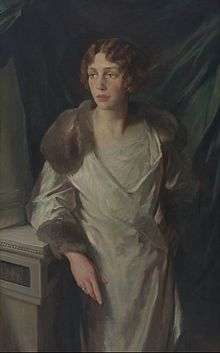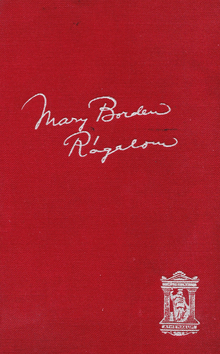Mary Borden
Mary Borden (May 15, 1886, Chicago – December 2, 1968) (married names: Mary Turner; Mary Spears, Lady Spears; pseud. Bridget Maclagan) was an American-British novelist and poet whose work drew on her experiences as a war nurse. She was the second of the three children of William Borden (d. 1904), who had made a fortune in Colorado silver mining in the late 1870s.[1]

Family background and early life
Mary Borden, known as May to her friends and family,[2] was born into a wealthy Chicago family. (Her brother, William Whiting Borden, became well known in conservative Christian circles for his evangelistic zeal and early death while preparing to become a missionary.) Mary attended Vassar College, graduating with a BA in 1907. On a tour of the Far East, she met and married Scottish missionary George Douglas Turner, with whom she had three daughters; Joyce (born 1909), Comfort (born 1910) and Mary (born 1914).
In 1913, she and Turner moved to England where Borden joined the Suffragette movement. She was arrested during a demonstration in Parliament Square for throwing a stone through the window of His Majesty's Treasury. She spent five days in police cells until bailed by her husband.
World War I and nursing
_and_Sir_Edward_Spears_in_the_Lebanon%2C_1942.jpg)
At the outbreak of the First World War in 1914, she used her own considerable money to equip and staff a field hospital for French soldiers close to the Front in which she herself served as a nurse from 1914 until the end of the war, see Voluntary Aid Detachment. There she met Brigadier General Edward Louis Spears, with whom she engaged in an affair at the Front. Her husband separated from her and took custody of their children. Following the dissolution of her marriage, she married Spears in 1918.
Writing
During her war-time experience she wrote poetry such as 'The Song of the Mud' (1917).[3] Notably, her work includes a striking set of sketches and short stories, The Forbidden Zone (1929), which was published in the same year as A Farewell to Arms, Good-Bye to All That and All Quiet on the Western Front. Even in this context, contemporary readers were disturbed at the graphic - sometimes hallucinatory - quality of work coming from a woman who had first-hand experience of life on the front line.[4]
The Forbidden Zone contained five long poems that describe what she saw and did working in the military hospital, and are full of passionate energy and compassion. Their style is reminiscent of Walt Whitman who also tended to the wounded on the battlefield, in his case during the American Civil War.
She wrote a number of other poems about the war and also about her affair with Spears which were not published in book form until 2015, one hundred years after they were written. Mary Borden, Poems of Love and War, edited by Paul O'Prey, was published in London by Dare-Gale Press,[5] distributed by the University of Chicago Press[6] in the US. Her war poems were slow to be recognised but now feature in several modern First World War poetry anthologies[7]
Her 1937 novel Action for Slander was adapted into a film the same year.[8]
World War II
Living in England between the wars, she was drawn back to France in the expectation of mounting some sort of aid facility similar to that she had run in the first war. With funds donated by Sir Robert Hadfield via his wife, Lady Hadfield, she set up the Hadfield-Spears Ambulance Unit, which was based in Lorraine until forced by the German Blitzkrieg to retreat across France before its evacuation from Arcachon in June 1940. In Britain, the unit re-grouped and received further funding from the British War Relief Society in New York. In May 1941, the Hadfield-Spears Ambulance Unit was attached to the Free French in the Middle East, before accompanying their forces across North Africa, Italy and France. Journey Down a Blind Alley, published on her return to Paris in 1946, records the history of the unit and her disillusion with the French failure to put up an effective resistance to the German invasion and occupation.[9]
A first person account of Lady Spears and the Hadfield-Spears Ambulance Unit can be found in the memoirs of Hermione, Countess of Ranfurly, To War with Whitaker.[10]
Later life
In her later life, she often returned to the United States and assisted her nephew-in-law Adlai Stevenson II in his run for the presidency, even writing some of his speeches.[11]
Centenary of the First World War Armistice
In November 2018 the Tower of London created an installation to commemorate the centenary of the ending of the First World War, called Beyond the Deepening Shadow: The Tower Remembers. This saw the moat filled with thousands of tiny flames and a soundscape composed by Mira Calix which is a choral setting of one of Borden's love sonnets[12] written at the Somme for Louis Spears.[13]
Works

- The Mistress of Kingdoms; or Smoking Flax by Bridget MacLagan (Pseudonym) (1912)
- Collision by Bridget MacLagan (Pseudonym) (play) (1913)
- The Romantic Woman by Bridget MacLagan (Pseudonym) (1916)
- The Tortoise (1921)
- Jane - Our Stranger (1923)
- Three Pilgrims and a Tinker (1924)
- Four O'Clock and Other Stories (1926)
- Flamingo (1927)
- Four O'clock (1927)
- The Forbidden Zone (1929) OCLC: 1852756
- Jehovah's Day (1929)
- A Woman with White Eyes (1930)
- Sarah Gay (1931)
- Action for Slander (1937)
- The Woman I Love (1937)
- Journey Down a Blind Alley (1946)
- You, the Jury (1952)
- Poems of Love and War (2015)
Footnotes
- Megan Mckinney. "The Bordens Struck it Rich in Leadville". http://www.classicchicagomagazine.com/the-bordens-struck-it-rich/
- "A Short Biography". www.maryborden.com. Retrieved December 8, 2015.
- https://archive.org/stream/2englishreview25londuoft/2englishreview25londuoft_djvu.txt | Full text of "English Review" August 1917, including 'The Song of the Mud'
- Conway, Jane (2010). A Woman of Two Wars. London: Munday. p. 150.
- "Dare-gale Press". Dare-gale Press. Retrieved February 12, 2016.
- "Poems of Love and War". University of Chicago Press. Retrieved February 12, 2016.
- O'Prey, Paul (2014). First World War: Poems from the Front. London: Imperial War Museum.
- "Action for Slander (1937)" – via www.imdb.com.
- Borden, Mary (1946). Journey down a Blind Alley. London: Hutchinson & Co. p. 296.
- To War with Whitaker, The Wartime Diaries of the Countess of Ranfurly 1939-45 ISBN 0-7493-1954-2
- "Mary Borden - An Extraordinary Life - Mary Borden: A Woman of Two Wars". www.maryborden.com.
- https://daregale.com/home/poetry/mary-borden/sonnets-to-a-soldier/
- http://www.miracalix.com/news/beyond-the-deepening-shadow-the-tower-remembers/
Further reading
- Everett F. Bleile, The Checklist of Fantastic Literature. Chicago: Shasta Publishers, 1948; pg. 56.w
- Jane Conway, A Woman of Two Wars: The Life of Mary Borden Munday Books, 2010.
- Hazel Hutchinson, The War That Used Up Words: American Writers and the First World War. New Haven, CT: Yale University Press, 2015.
- Wyndham Lewis, Blasting and Bombardiering. 1937.
- Paul O'Prey (ed.), Mary Borden, Poems of Love and War. Dare-Gale Press, 2015.
- Max Wyndham, Under Two Flags: Life of Major General Sir Edward Spears. 1997.
External links
- Works by or about Mary Borden at Internet Archive
- Works by Mary Borden at LibriVox (public domain audiobooks)

- Review of Mary Borden, Poems of Love and War http://www.centenarynews.com/article/book-review---poems-of-love-and-war
- Dare-Gale Press http://www.daregale.com
- https://maryborden.org/